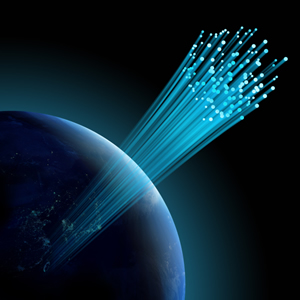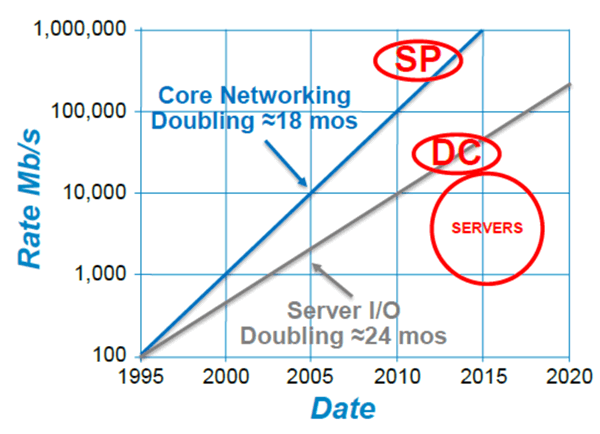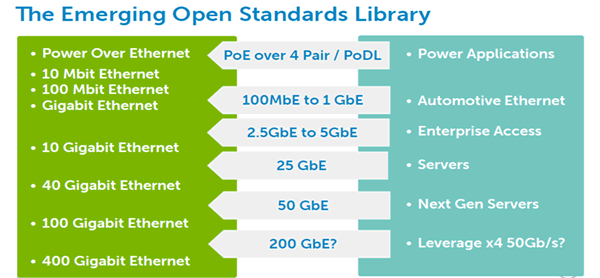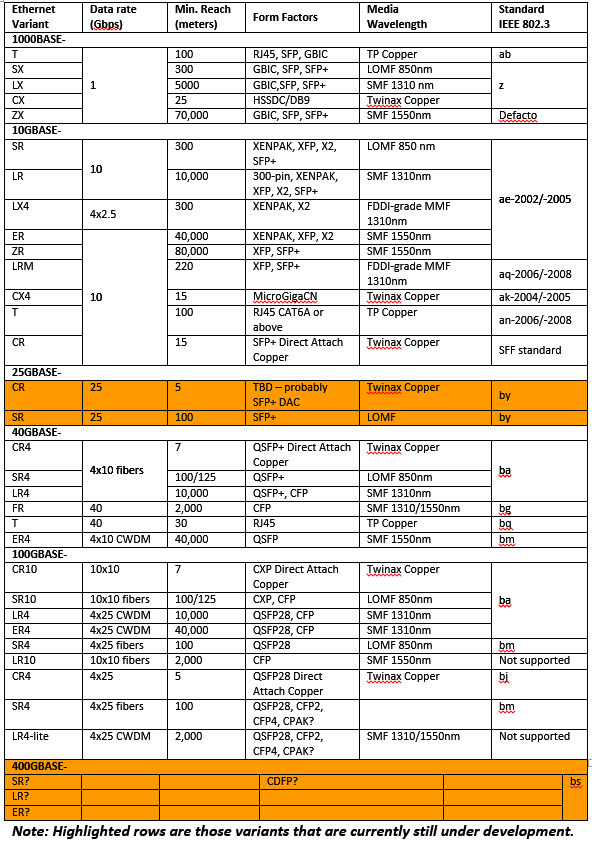Fiber Optic Technologies in Networking
While not yet pervasive in all sectors, fiber optic connectors are present and growing in all market sectors. In this excerpt from a recent Bishop & Associates market report, we look at the effects they’ve had on data center networks and what is still to come.
 Ever since Bell Laboratories developed the first glass fibers in 1973 to be used in communications systems, proponents have been saying it would take over the world. While this has not yet happened, we are seeing increased adoption of fiber optic systems in all kinds of applications. Fiber optics has become important in every market that Bishop & Associates covers. While not yet pervasive in all sectors, fiber optic connectors are present and growing in all of them. Driven by the Internet of Things, the communications and computer markets are where most of the fiber optic connectors are found, but these “things” are also found throughout every other sector.
Ever since Bell Laboratories developed the first glass fibers in 1973 to be used in communications systems, proponents have been saying it would take over the world. While this has not yet happened, we are seeing increased adoption of fiber optic systems in all kinds of applications. Fiber optics has become important in every market that Bishop & Associates covers. While not yet pervasive in all sectors, fiber optic connectors are present and growing in all of them. Driven by the Internet of Things, the communications and computer markets are where most of the fiber optic connectors are found, but these “things” are also found throughout every other sector.
Networking Technologies – LAN, SAN, and HPC
While most corporate networks are still running multiple-Gigabit connections, 10G Ethernet passed the milestone of one million ports installed in 2010. Now, data centers are quickly implementing 40G, however new developments around 25G may stunt this growth.
Data center networks have historically been hierarchal, but they are beginning to progress in to flatter topologies. Some higher-availability networks needed to change due to demands placed on them from server virtualization and some network convergence. Whether these trends will prevail for the general data center market remains to be seen, and when speaking to data center managers, the large majority say that instead of convergence, they see the network diverging because there are just too many applications that have specific needs, such as load balancing. According to one end user, a separate box will always handle this, and the same will be true for firewalls and other security functions. However, there are many equipment manufacturers that tout software that will perform these functions. Bishop believes there is quite a disconnect between what equipment manufacturers are developing and what some end users really want; therefore the hierarchal model will most likely continue for at least the next five years and probably beyond.
The process for standardizing the next Ethernet is the responsibility of the IEEE’s 802.3 working group. Specifically, 40G and 100G were standardized through the IEEE 802.3ba Higher Speed Ethernet Task Group (HSTG). The standard was published in June of 2010. Current IEEE 802.3 projects associated with fiber-optic networking include 40/100G fiber optic, 400G, Gigabit Ethernet over plastic optical fiber, and 25G Ethernet. In addition, there is investigation into 2.5G and 5G variants needed to more cost-effectively serve small and medium-sized businesses along with wireless access points. The following chart shows the divergence of data rate progression between service provider networks and data centers.

Service provider and DC data rate divergence (Source: TIA Data Center Workshop 2014)
Below we see how the IEEE intends to fill the gaps in its data rate portfolio.

IEEE development standards (Source: TIA Data Center Workshop 2014)
A summary of all the current multi-Gigabit Ethernet variants is shown in the following table:
Gigabit Data Communications Ethernet Variants

There are several observations that can be seen by looking at the Ethernet variants in this fashion:
- Gigabit Ethernet has progressed through a couple of form factors but has finally settled on two – RJ45 and SFP+. The RJ45 is used for structured cabling connections while the SFP+ is used for short-reach copper twinax connections within a rack, and fiber for anything over 100m long. For local-area networking, most installations use the RJ45 and Category cabling for everything up to 100m; LOMF up to 300m; and SMF beyond 300m.
- For 10G, there are entirely too many variants and form factors. It is one of the reasons why there was a delay in the adoption of 10G. However, over the last several years, the market has shaken out and the SFP+ has prevailed. While XFPs still exist for some longer-reach and legacy applications, most transceiver manufacturers have solved the power consumption and heat issues with the SFP+ designs so that most 10G Ethernet interfaces today are SFP+, regardless of reach. This means that going forward LC connectors and cable assemblies will dominate the 10G optical space. Although SFP+ has made inroads into the 10G market, 10GBASE-T has had a major impact in the server and switch markets. 10GBASE-T has reached mainstream for LOM on servers and into switch ports. It is now about 50% of server-to-ToR switch connections.
- Parallel optics and wave division multiplexing (WDM) are used for 40/100G Ethernet and beyond.
- For 40/100G, the IEEE did not want to make the mistake of too many variants and form factors again, so it consciously limited them; but, in our opinion, it may have restricted them too much. By reducing the LOMF optical reach to 100m over OM3 and 125m for OM4, the IEEE left a huge gap in distance covered for data center applications – in fact, a two-orders-of-magnitude gap – from 100m to 10,000m. This results in an enormous gap in cost as well. For example, a 40GBASE-SR4 QSFP+ module cost is about $600, while the 40GBASE-LR4 costs about $4,000. So it is cost-prohibitive to design a data center with connections longer than 100m. This is not realistic. In order to address this shortcoming, the top transceiver manufacturers are working on eSR4 products that have the potential to reach to 300m. The IEEE could not come to consensus on a new variant so transceiver manufacturers have released these non-standards-defined products. The problem is that they may not be interoperable.
- The 40GBASE-T IEEE effort started in late 2012, with its first formal task force meeting in May 2013. Its current schedule reflects an April 2016 standard release. For the first time, the copper variant will be shielded only. While some existing Category 7A products seem to be sufficient to meet the specifications, there is a new Category 8 development effort currently underway in the TIA to support the 40GBASE-T standard.
- Notice in the table above that there are different signaling schemes and form factors between 100GBASE-CR10, SR10, and 100GBASE-LR4. The CXP that was chosen for short-reach copper and LOMF is not suitable for longer-reach SMF operation. Even though most of them were involved in the IEEE process, equipment manufacturers are not happy about this because that means their products must support two different form factors at the same time. It may also doom CXP to only the initial products until another, better form factor can be developed that will cover both cost effectively – probably the QSFP28.
- The LR10 variant is not standardized, but is backed by a consortium of vendors and end users – including Google and Facebook. Whether this will take hold in the industry at large remains to be seen, but some industry leaders are boasting that it is actually selling very well with tens of thousands of units shipped per year so far.
- A 25G project was started in 2014 and is expected to become the preferred server-to-switch connection within a rack in the Internet data center very quickly. These connections will be primarily copper, but an LOMF variant is included in the standard.
This article is an excerpt from Bishop & Associates’ Fiber Optic Connector Market 2015 – 2020, a four-chapter, 124-page research report that provides an in-depth analysis of fiber-optic connectors and technologies. It investigates the effects of attenuation on signal strength, as well as other impairments such as skin effect, impedance control, skew, and crosstalk; fiber-optic connector market trends; and the different technology developments that lead into new FO connector designs. Top component manufacturers that deliver connectors to this industry are reviewed, and five-year forecasts of FO connectors are presented as well.
All information in this article was current as of the research report’s publication date in August 2015.
No part of this article may be used without the permission of Bishop & Associates Inc. If you would like to receive additional news about the connector industry, register here. You may also contact us at [email protected] or by calling 630.443.2702.




